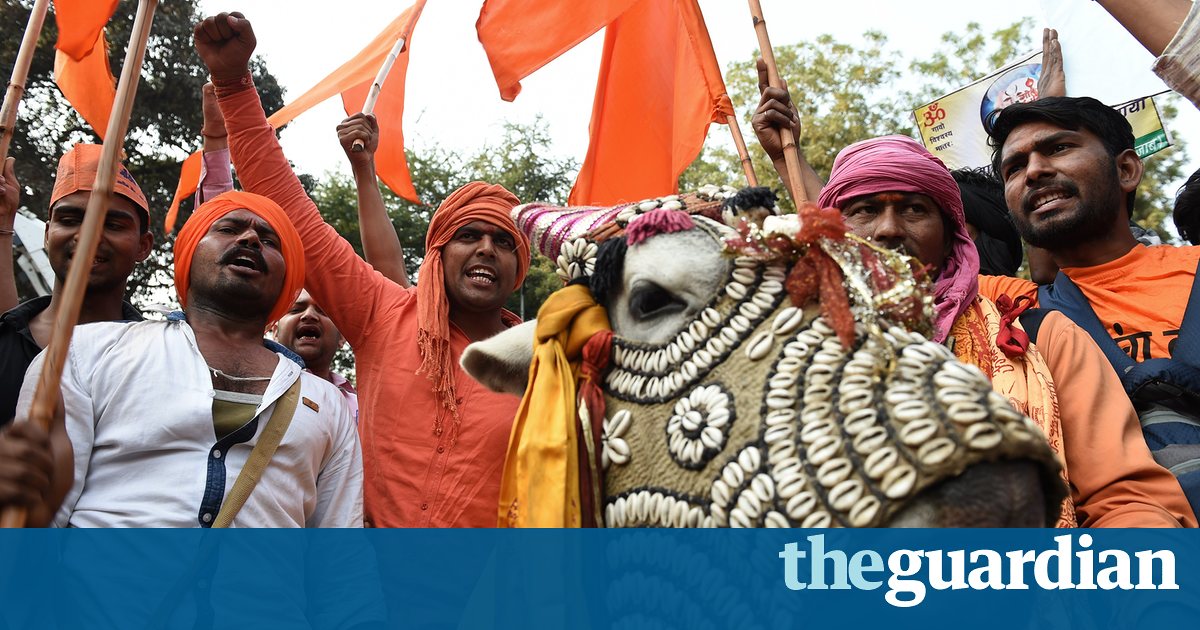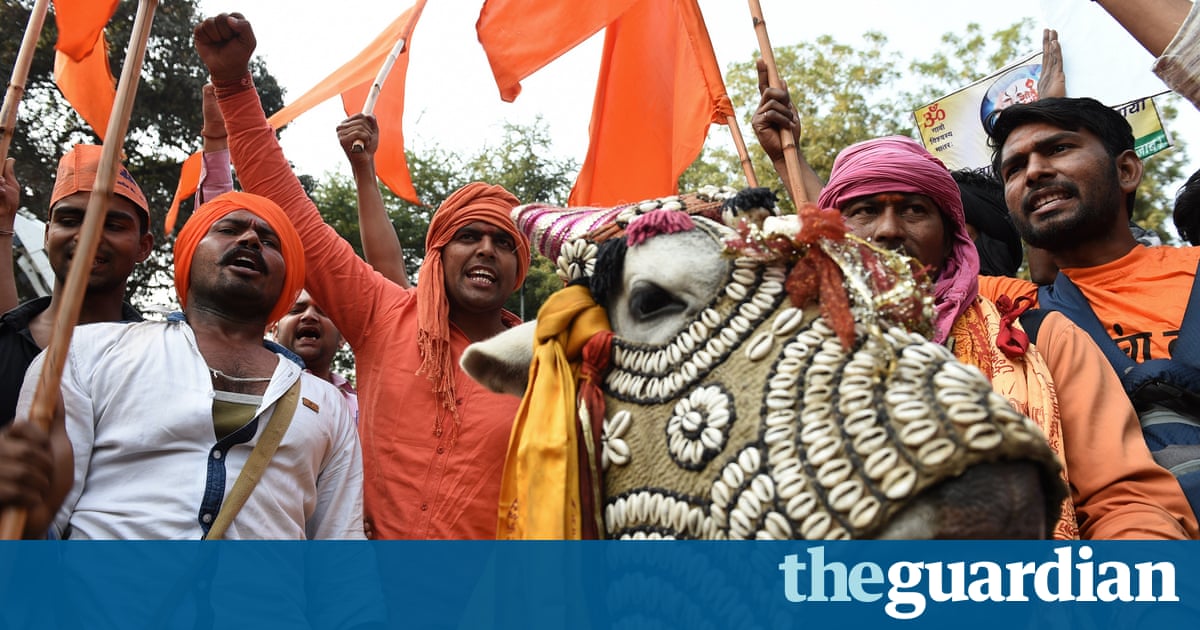A revolver is shown as a patrol sets out to discover if any cows are being illegally transported. Photograph: Michael Safi for the Guardian Outside, a convoy of about three dozen vigilantes are preparing to leave for the evenings patrol, and the excitement inside the cramped, humid office is palpable: the men say they have received a tip that a smuggling operation is underway.
The reverence these men, and most Hindus, feel for cows is indeed ancient. The animal is honoured as a selfless nourisher, and the embodiment of the Hindu principle of non-violence. But the zeal to save cows is a modern phenomenon, and masks a more complicated relationship.
Many Hindus in Kerala and Tamil Nadu eat beef; so do members of less-powerful castes in need of a cheap source of protein. India is also the worlds largest beef exporter though most of what it sends abroad is actually buffalo meat.
Protecting the docile cows that lumber through Indian traffic has, since the late 1900s, become a stand-in for something larger, says Neera Chandhoke, a columnist and retired professor of Indian politics.
At first, a sharp backlash by Hindus to British colonial rule, wanting to protect their religion and culture from the alien colonial gaze, she says. And now, obviously aimed at the Muslim community.
***
It is past 11pm when the patrol finally sets out in a convoy of four-wheel-drives. Up front is Yogendra, the bearish, 35-year-old leader of the Haryana vigilantes, looking every part the holy man in a beard and white robes.
In our beliefs, it says the cow is the mother of the whole world, he says from the front seat. Every country and every state should believe in it.
Yogendra says he was persuaded to join the fight against cow smuggling 14 years ago, on the advice of his guru; now he heads a vigilante force 5,000-strong.
The men are all daily wage labourers, left behind by Indias surging, but uneven economic growth. Those patrolling tonight are also young.
I try to motivate more youth than middle-aged men, he says. [The older men] are more into reasoning and they argue, so it wastes more time. But youth, we just need to tell them that cow is our mother and we need to protect her. So, its easy to motivate a youth.
He passes around his phone, playing a gruesome video of a cow being slaughtered, in obvious agony, and another of a live rabbit being hacked apart with a butchers knife.
In regular intervals we motivate the boys, he says. We show them videos of how a cow, who is our mother, is tortured. We motivate them emotionally.
Smugglers often fight back, throwing stones, sand or chilli powder, he says. Some carry weapons. Five of his volunteers have been killed, and the families of the men sometimes ask their sons to leave the vigilante group. But these boys tell their family to understand the cause and support them, he says.
Even if they dont, the boys work for us anyway.
We pull up at a series of archways along National Highway 1 at Panipat, where trucks line up to pay a toll, and the men surge out in a horde towards the headlights.
They slam the sides of the trucks to rouse any sleeping cows, sniff between the crevices for dung, and scale the vehicles to inspect whats inside. It is unorganised and revelrous, driven by a mob energy, and another guru on the patrol admits the men can be hard to control. Accused smugglers have been killed and beaten before they can be handed to authorities.
We keep repeating how they have to behave, the guru says. [It is] difficult to stop these boys when they find something suspicious.
A police car pulls up and the officers watch warily. Corrupt, one of the men pronounces, gesturing at the vehicle.
Haryana police have been alternately accused of helping gau raksha groups and taking bribes from smugglers. Bharti Arora, the officer in charge of stopping cow smuggling in the state, denies both charges. She says the gau raksha soon to be officially registered and licensed in Haryana are permitted to give us information, but have been warned to quit their vigilantism.
Police do not give much support, Yogendra says. Several members of the group claim they have been beaten by corrupt officers. They show me a video of one officer, who they say was caught riding with smugglers, begging the incensed gau raksha for forgiveness.
Maybe abroad the police work with discipline, but here, if we need their help at night, they first look for a subordinate, Yogendra says. Or they need to look for their car keys, and by that time the smugglers get the opportunity to run.
But at the highest levels of the Indian government, cow protection is firmly on the agenda. The prime minister, Narendra Modi, was elected in 2014 promising to end the pink revolution: a supposed ramping up of the meat industry and indifference to cattle smuggling and slaughter.
In office, Modi and his Bharatiya Janata party (BJP) have championed a muscular Hinduism that critics say sidelines Indias ethnic and religious minorities and BJP-led states have toughened jail sentences for cow trafficking and slaughter.
Modi likely sees the vigilantes as irritants, says Swapan Dasgupta, an Indian journalist and MP. But the presence of an ardent Hindu nationalist in power has energised extremists across the country, and there are people who are capitalising on it, he says.
As the reports of deaths and injuries from gau raksha violence grew throughout this year, Modi said little until August when, after weeks of protests by Dalits, he condemned anti-social elements among the vigilantes.
Activists are now pushing for the cow to be installed as Indias national animal, and the government is probing the possibility of housing all stray cattle in the country in gaushala, or cow shelters.
The Guardian visited one of these shelters the day before joining Yogendra on patrol. Based in a quiet village called Nizampur, among grassy fields and ponds, the Jai Shree Shyam Gaushala was a world away from the exhaust-choked freeways where the vigilantes spend their nights.
Two workers at a gaushala, where strays cows are given homes and attended to for life. Photograph: Michael Safi for the Guardian Inside muddy pens on the property lived thousands of cows and bulls, deemed surfeit to surrounding farms, and which in the recent past might have been sold for slaughter. Here, they were be tenderly cared for until their natural deaths.
Since I was a child I wanted to take care of cows, said Ajmer Singh, the shelters operator.
He decided to start the gaushala after the birth of his last child, and first son, Amar, whose first word was cow.
Singh too goes on patrol with the local gau raksha, but agreed with Modi there were anti-social elements who are trying to spread violence in the name of cow protection.
Still, he said, illegal butchering in Haryanas Muslim villages was a big problem. He was adamant about the punishment for anyone caught. They should be killed immediately, he said.
***
In Panipat, nearly two hours of combing vehicles has turned up nothing, and the vigilantes are growing listless. They stand by the side of the road jostling, or play with their phones, and suddenly look more like schoolboys on a lark than hardened religious zealots.
Then a great shout goes up. Two vigilantes across the freeway signal for the others to join them. Theyve scaled an ageing red truck covered in rope and a tarpaulin, and can see cattle tied up inside.
The men surround the vehicle and go to grab the driver, who fumbles to show them sheets of paper. The adrenaline ebbs: the cattle are being transported legally, and the men have to let the driver go.
After two more stops that night, both fruitless, the patrol finishes at a farmhouse along a smugglers route deep in Haryanas hinterland.
It is time to leave; but first, the men join Yogendra at a table. A crowd forms around us as he delivers a brief sermon. He gestures for the final ritual of our patrol, and one of the men disappears into the farmhouse, emerging with a tray, offering around glasses of fresh milk.

